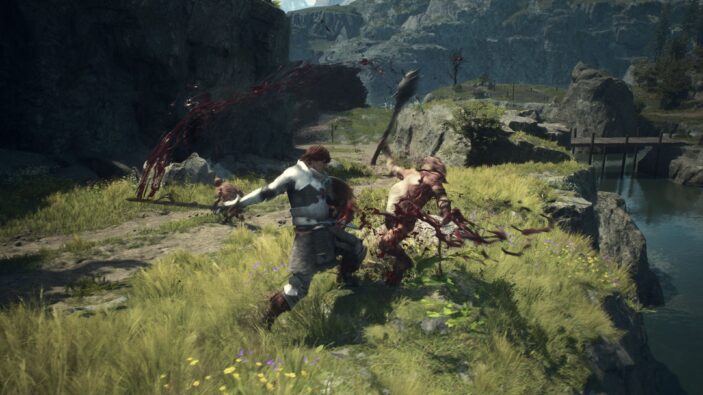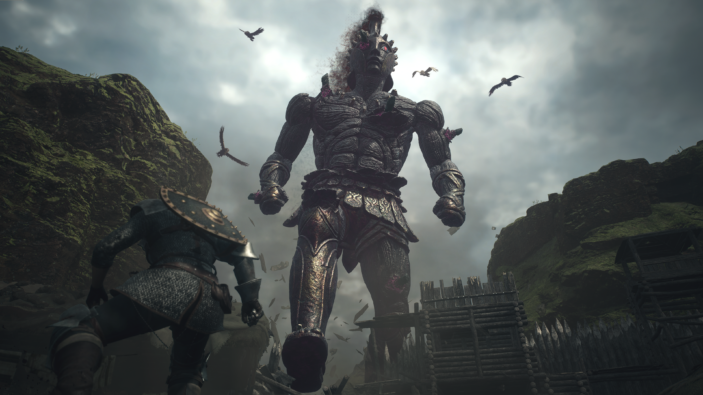
I have vague memories of playing the first Dragon’s Dogma, mainly the enhanced Dark Arisen version, but I’ll be the first to admit that nothing stuck. I don’t remember hating it, but hadn’t really held enough love in my heart to make a return. Dragon’s Dogma 2 felt like the fresh start I needed, that second chance to dive into the breach once more for a rollicking fantasy adventure.
Dragon’s Dogma 2 doesn’t necessarily do much to redefine or reinvent the action RPG genre as a whole but certainly strengthens some of its best features. As a result, the overall experience makes for a functional, enjoyable ride that provides an engaging world, solid action and deep character customisation.
The Heart of a Legend
While Dragon’s Dogma 2 presents itself as a sequel, it’s more of a quasi-remake, retelling the events of the first game with a fresh twist. You play as the Arisen, whose heart is stolen by a dragon early on in battle. Seemingly dead, you have been revived to take on and slay the dragon and restore the land to its former glory. There’s a little more going on in terms of politics and character development which I would rather not spoil, but this is largely and quite literally, the same story as the first Dragon’s Dogma.
On your quest, you’ll explore the kingdom of Vermund and its far reaches, slaying beasts and befriending supporting charters known as Pawns, built from the game’s various classes each with their own tricks and tips. Early on, the experience has you coming to grips with your abilities and general combat, by taking out various enemies like trolls and goblins.

While most missions are relatively straightforward, there are a few neat missions that allow you to take on multiple objectives in a certain order, each with their own consequence depending on your method of completion. For example, if you’re tasked with killing three separate beasts in three distinct towns, you might find your last beast has already destroyed that local village, making its inhabitants and resources like the local inn, unavailable for save points and class changes.
The voice acting is also decent across the board, and the early hours of the game carry a fair amount of cinematic cutscenes, which admittedly drop off as the hours progress. The story can take a back seat at times as a result, but it’s never really wasting your time or dragging things along when it’s brought back into the foreground.
Live to Fight Again, Arisen
Combat is still the heart of Dragon’s Dogma 2, and it shows in almost every aspect. You’ll be able to choose from four basic classes (also known as vocations) initially, each with their own unique abilities. The Fighter class feels like the most straightforward option, gracing you with a sword and shield for close-range melee combat. The Thief class gives you dual blades and makes you feel much more agile, while the Mage class grants you with magical projectiles and finally, the Archer class fits you with a bow and arrows.
You’ll generally have access to a range of light and heavy attacks, along with unique special abilities depending on your chosen class. It feels weighty and responsive as you manage a dedicated stamina bar in the process. Players can also utilise a dedicated grab ability which can be used to hurl smaller enemies about and even climb larger ones.

While most bosses and tougher enemies are larger in size, this makes for some incredible fun, as you climb the back of a large troll, or hang on for dear life as a griffin takes off with you on the side of it. Scurrying about on these larger enemies also brings out a fantastic sense of scale and even some impressive AI, as they make their best attempts to shake you off, or even grab you if you get a little carried away.
Ranged weapons and spells also do a great job at shaking up combat, even if I chose to stick with the Warrior and Thief classes for most of my playthrough. Physics also plays a huge part in combat, as you manipulate both enemies and the surrounding environment to gain the upper hand. Is that troll chasing you across the bridge? Destroy the bridge while it’s walking across and you’ll cause it to fall through, or possibly hang onto each side, allowing you to pass over it for good measure.
Either way, combat is certainly functional and chaotic in the best ways, but it carries a fair sense of difficulty and challenge as far as moment-to-moment gameplay is concerned. You’ll encounter several unique bosses and enemy types, but it’s all rather tense when you rarely feel like you have the upper hand without the relevant preparation, weapons and abilities along the way. There’s plenty to find off the beaten path, and I recommend exploring as much as possible to seek out these encounters and flesh out your current class.
Classes themselves also feel great, and you can even change your vocation at any given time by stopping at the local inn. Progression and dedication certainly aid time spent with each class, along with advanced vocations you can unlock later on, which grant players extra special abilities that change the overall style and pace of combat. But even so, it’s simply nice to be able to change things up along the way when you see fit. Your character is also fully customisable, from looks to basic statistics like health, stamina, strength, defence and magical qualities, should your vocation suit.
Players can also find and utilise multiple weapons, which are generally made for a certain class. Along the way, you can even upgrade and buff these weapons with discovered materials, three of which can be assigned to weapons to enhance their effectiveness in combat. It adds to the overall depth of combat and feels a little more involved than it did in the first Dragon’s Dogma.

These also apply to Pawns, which can be buffed along the way as they accompany you on your journey. Up to three Pawns can be recruited out on the open road, or summoned at The Rift, best described as spiritual sites scattered throughout Vermund. You will create your main Pawn which will accompany you the entire way, and can even head off independently to complete quests and help other players on their journeys.
Players can even recruit the main Pawns of other friends online, adding a sense of community and multiplayer fun throughout. You’re rarely alone, and the Pawns themselves can lend a hand in hilarious ways, catching you from falls, and being launched across chasms to help you across difficult paths. It’s a great system that aids general combat and gameplay but also makes the world feel lived in and constantly existing, even when you’re not playing.
Look the Part
Dragon’s Dogma 2 didn’t really blow me away on the PlayStation 5, but it certainly looks decent enough. Textures are generally polished and environments detailed, even if the general colour palette of the world feels a bit bland and muddy at times. But the animations are mostly smooth and I rarely came across any strange gameplay bugs that affected my time with Dragon’s Dogma 2 in any significant way.
The performance, on the other hand, leaves a little more to be desired. Capcom’s RE-Engine doesn’t really hold up when it comes to delivering a smooth 60 FPS experience. In fact, it doesn’t deliver it at all. While you can opt-in for a capped 30 FPS experience, the uncapped alternative barely hits and stays above 40 FPS. It’s far from broken, but I would be lying if the experience didn’t drop considerably in busier areas and packed combat scenarios either.

It’s worth noting here that Dragon’s Dogma 2 also includes microtransactions. But let’s hold up and take a step back. Sure, these microtransactions are lingering around the game through your platform’s store rather than within the game itself, but they’re all still quite silly.
For a couple of bucks, you can buy pretty much everything that is given to you in-game, which can also be acquired quite easily. It’s annoying that they exist, but they can be avoided entirely with no real consequence to time spent in Dragon’s Dogma 2, as there’s no real grind required other than playing normally through the game. If you want more Rift Crystals to spend on hiring Pawns, they’re there. But I haven’t spent a cent on Dragon’s Dogma 2 in-game and I feel fine about it.
Final Thoughts
Dragon’s Dogma 2 feels like it’s crafted from the best parts of many existing action RPG titles, even if it’s not really pushing boundaries of its own. The story is solid enough but does draw from its predecessor quite heavily. The combat is certainly deep and functional, along with progression, but feels incredibly familiar in the hands. The Pawn system is admittedly awesome, and something I enjoyed tinkering with throughout.
As a result, there’s a great time to be had with Dragon’s Dogma 2. While the general performance and muddy visuals falter at times, they in no way detract from the overall experience, making this one of the best action RPG titles in recent memory.
FOUR STARS (OUT OF FIVE)
Highlights: Engaging combat and progression systems; Pawns make for heaps of fun; Plenty to do and see; Classes all feel great to play around with
Lowlights: Muddy visuals and average performance; Rather pointless microtransactions
Developer: Capcom
Publisher: Capcom, Capcom U.S.A., Inc.
Platforms: PlayStation 5, Xbox Series X/S, Windows PC
Available: Now
Review conducted on PlayStation 5 with a code provided by the publisher.
